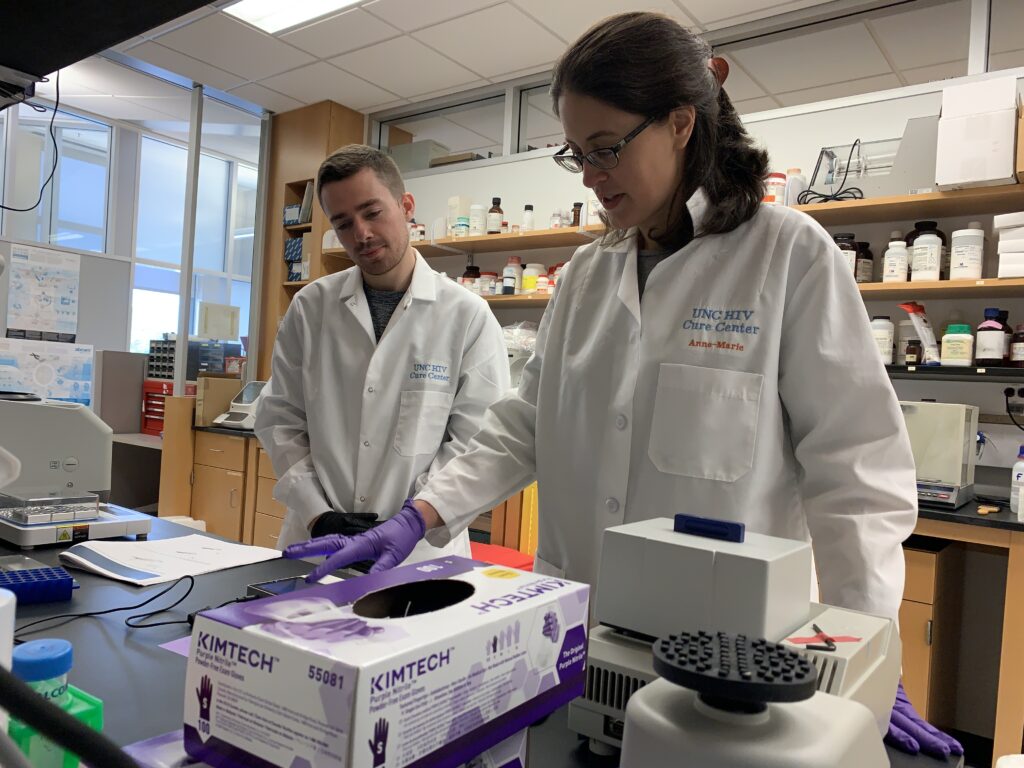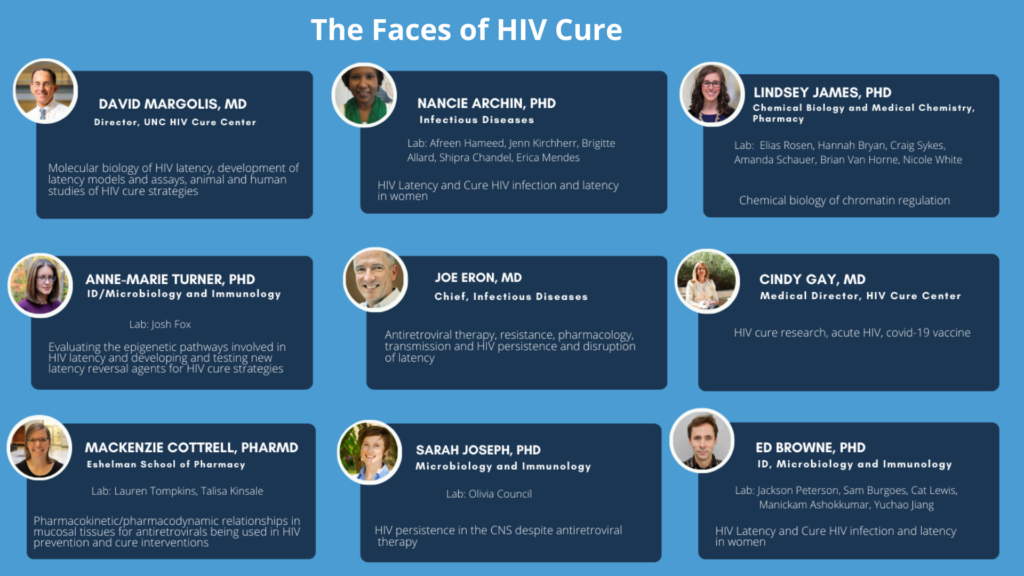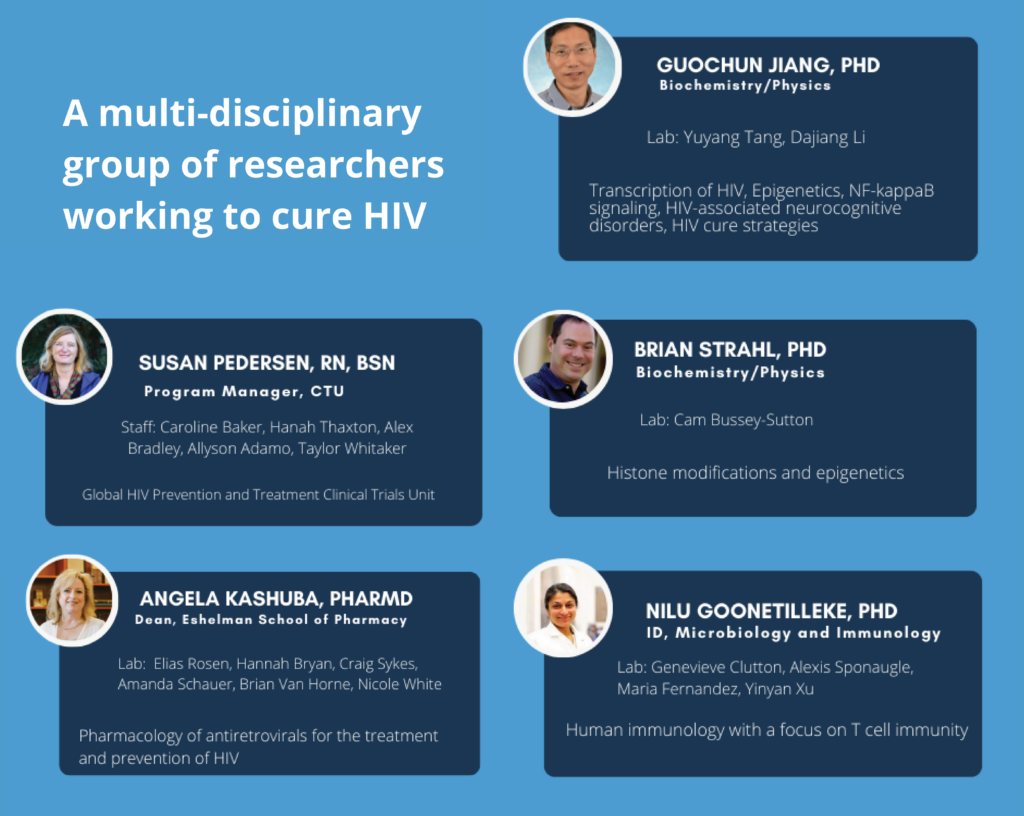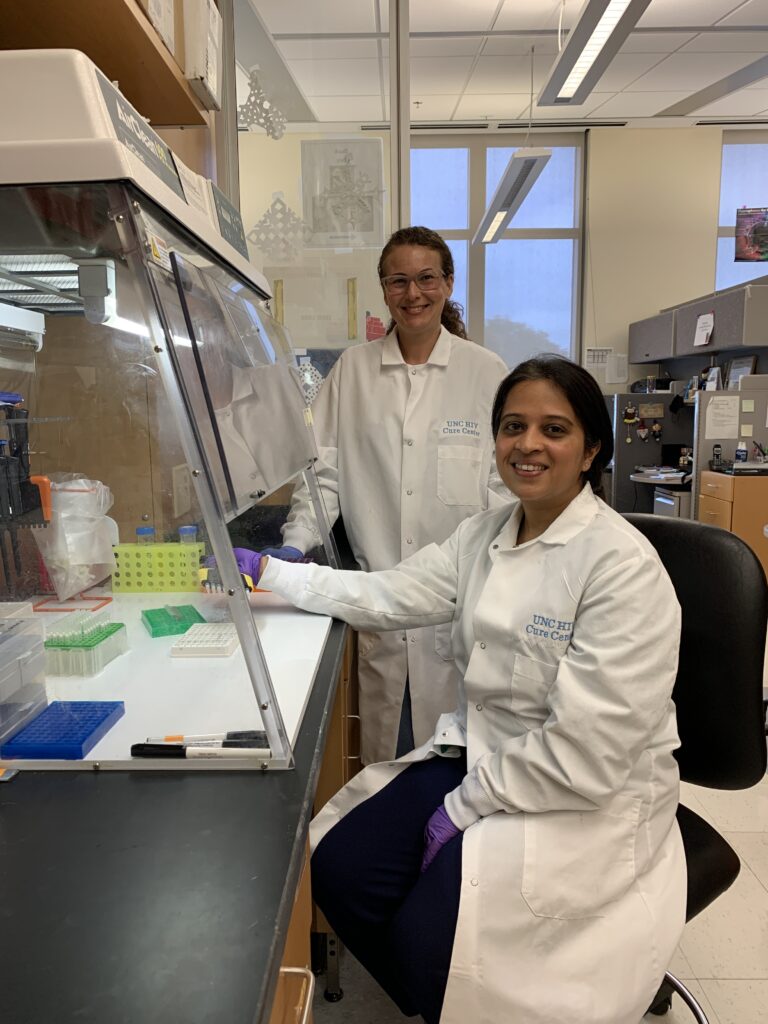HIV/AIDS has been around for approximately 40 years, but many researchers say the end is in sight. The question is, will it be in our lifetime or just around the corner? This is a spotlight on the HIV CURE Center, comprising approximately 55 researchers and students, featuring David Margolis, MD, the director, Nancie Archin, PhD, a research faculty member, and Jenn Kirchherr, PhD, the laboratory manager.
What is the HIV Cure Center?

Jenn Kirchherr: “The HIV Cure Center is a multi-disciplinary group of researchers who are all interested in curing HIV, and each lab has its own specialty. We have immunologists, microbiologists, molecular biologists, biochemists, and infectious disease specialists–all working on the big picture, but everyone has their own niche research. We all come together to work on the problem of curing HIV.”
What is the Center’s relationship to the Institute for Global Health and Infectious Diseases (IGHID)?
David Margolis: “We are a consortium of researchers supported by IGHID’s Research Management expertise. The grant administration staff (pre and post award) work with our investigators on all aspects of grant and funding management. Our investigators also conduct clinical research through IGHID’s Clinical Trials Unit, also known as the UNC Global Research Group or Global HIV Prevention and Treatment Clinical Trials Unit.”
When and why was it formed?
David Margolis: “In 2011, the US National Institutes of Health (NIH) awarded a large five-year grant to a group of investigators to implement Collaboratory of AIDS Researchers for Eradication (CARE) . This consortium, centered at UNC, included labs and researchers from all over the world. It was established to determine how HIV became latent, or hidden from both antiviral drugs and the immune system, with the goal of developing treatments to unmask latent HIV and clear HIV infection (cure). This collaborative work included many researchers here at UNC, myself included. Subsequently, we engaged in parallel collaborations with the pharmaceutical industry towards the same goals, and as the size and scale of the effort grew, the UNC HIV Cure center was founded.”
What does the word “cure” mean to the team and your work?
Nancie Archin: “I hear all the time from people living with HIV patients how they would like to have a cure just because of the stigma associated with being HIV infected, and just to be able to live a day-to-day life without taking any medicine.”

David Margolis: “No one knows when we’ll find a cure for HIV/AIDS. In many ways it’s like searching for a cure for cancer. But with the stunning success of combination antiretroviral therapy (ART) to prolong and improve quality of life for persons with HIV infection, we’ve been able to pivot towards studies aimed at finding “a cure.” The mere idea that a cure for HIV might be possible has energized researchers and the community towards achieving this goal. Funding agencies, both governmental and private, have targeted HIV cure as a high priority; many in the field have responded to these initiatives and the cure research agenda is robust. We have begun to develop drug and immunotherapy approaches to target persistent HIV, the tools needed to cure HIV infection.”
Jenn Kirchherr: “We’ve made great strides but we haven’t found the breakthrough to be able to eradicate the virus, which is genetically diverse and able to evade the immune system. The virus is able to integrate into the cells, hiding from the immune system. This creates a reservoir of virus that is not affected by antiretroviral medications. Currently, drug treatments are able to remove detectable virus from the bloodstream. But the problem is that without medication, the virus inside the cells can then come out and rebound. What we’re doing in Dr. Margolis’s lab is trying to find a way to stimulate these cells to drive the virus out and to simultaneously stimulate the immune system to get rid of the virus infected cells. We hope the combination of these two strategies will give us the edge we need to eradicate the virus and cure HIV.”
Who does the Cure Center work with?
Jenn Kirchherr: “The Cure Center is a consortium of labs and researchers at UNC, and each lab is working on three to four projects at any given time. Principal investigators with labs include David Margolis, Nancie Archin, Ed Browne, Nilu Goonetilleke, Anne-Marie Turner, Guochun Jiang, Sarah Joseph, Brian Strahl, Lindsey James, Angela Kashuba, and Mackenzie Cottrell.”
David Margolis: “The Center largely operates through NIH grants and contracts, but also through pharmaceutical partnerships.”

Tell us how the Center operates.
Jenn Kirchherr: “Beau Miller-Martini is the director of operations. I manage the daily laboratory research activities of the Cure Center. I make sure everyone has what they need for their experiments, that the equipment is working and running smoothly, and try to coordinate between investigators. I do perform some experiments myself but see myself as support staff for the principal investigators and scientists. We have weekly meetings where one of the labs will present, giving an overview of one of the projects that they’re working on. This is a good forum to share ideas and enhance collaboration. Most of our labs are in the Genetic Medicine Building and the first, second, and third floors.”
What is it like working in the Center?
David Margolis: “It’s great to be in a place where people want you to succeed and people want to work together. It’s an institutional tradition and part of it comes from a feeling of pride for the university and its role in the community and the state of North Carolina.”
Nancie Archin: “It’s very exciting to be in the field right now because the whole world is galvanized toward finding a cure for HIV infection.”
Jenn Kirchherr: “I enjoy the actual physical work of being in the lab. At the HIV Cure Center, I feel like we’re working towards an important goal. There is a nice comradery of people with diverse backgrounds and experiences working together. People are willing to collaborate and share their ideas and what they’re doing without there being intense competition.”
What motivates you in your work each day?

Jenn Kirchherr: “I see the HIV epidemic as a global catastrophe that has been forgotten over the years. In college, I read And the Band Played On by Randy Shilts. It’s about the history of the AIDS epidemic in America and how the medical, political and social establishments have dealt with the crisis. I was horrified by my perceived lack of response by the U.S. government and how stigma and misunderstanding contributed to the escalation of the epidemic. I wanted to help by doing research to find a vaccine and a cure. I love viruses. I find HIV fascinating, the way it can change and evolve to be so resistant and resilient to our attempts to eradicate it. It’s had a huge toll on humanity, especially in Africa, and has devastated generations. I adopted my son from Ethiopia. He does not have a direct connection to HIV that I know of, but the area where he is from has been very affected by HIV.”
David Margolis: “I started medical school when the AIDS pandemic was first recognized. I was always inspired by doctors who tried to develop new and better treatments for difficult diseases, and this drew me into both clinical and basic research on HIV. As we developed drug therapy, it became obvious that life-long therapy was not ideal. Although it is unclear if a cure for HIV infection can be developed, someone has to try.”
Is there a particular achievement that has been most gratifying to you all as a Cure Center?
David Margolis: “There are several. First, just the growth of the Center, and the synergy of people working together, moving the field forward, and growing their careers and research groups. And second, the several seminal contributions we have made to the field in the last 15+ years: the first description of latency reversal agents (LRAs), testing these in animal models and humans, developing new classes of LRAs, advancing the understanding of how to measure latency, and understanding the dynamics of the entry of viruses in to the latent reservoir, which gives us new directions for cure strategies.”
What’s the best advice you’ve ever received?
David Margolis: “Semper ubi sububi”
Editorial note: This well known Latin maxim roughly translates to “always wear underwear.” In other words, and especially when working in the lab, “always be prepared.”
The Institute for Global Health & Infectious Diseases (IGHID) attracts people who are driven to make big change. From principal investigators and grant managers to regulatory specialists and study coordinators, everyone has an important role to play in what we do around the world. We are pleased to highlight the work of the people who proudly serve IGHID.
